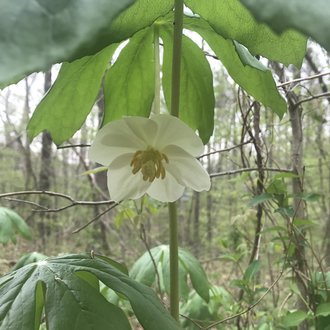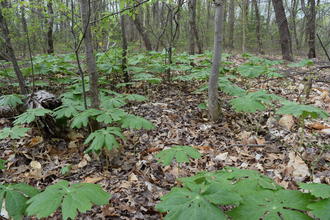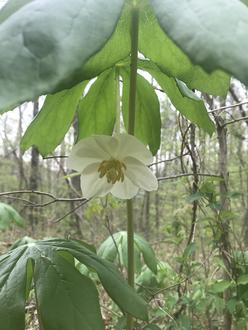Mayapple (Podophyllum peltatum L.)
Also known as may apple.
↑Summary
A long-lived perennial plant native to forests of Eastern North America.
↑Range - Expand
| Legend | Color |
| Native | |
| Native or Expanded | |
| Native or Not Present | |
| Expanded |
This tentative map is based on our own research. It may have limited data on Canada and/or Mexico, and there is some subjectivity in our assignment of plants as introduced vs. expanded. Read more in this blog post.
Although this plant occurs somewhere in each of these regions, it may only occur in a small part of some or all of them.
This species is widely planted in gardens, and can escape into the wild. It has established slightly northeast of its native range in this manner; we mark these populations expanded because they are directly adjacent to its native range.
↑Habitat
Moist, deciduous woodlands, including both closed-canopy forests and more open forests and forest fragments. Mayapple is found in intact wild forests, but it adapts better to habitat fragmentation and disturbance than many species found in these ecosystems.
It has been classified as obligately mycorrhizal, meaning that it is dependent on a symbiotic relationship with soil fungi.
↑Life Cycle
Mayapple is a long-lived perennial that is sometimes viewed as a spring ephemeral, but that has a slightly longer growing season than most spring ephemerals. Reproduces both vegetatively and by seed, but puts more energy into vegetative reproduction. Establishes large colonies which produce both flowering and non-flowering stalks.
Seedlings are slow to get established, and producing infertile stalks and not spreading by rhizomes for the first few years. Eventually, begins spreading by rhizomes to form a colony, and starts producing flowering stalks.
Plants are usually self-infertile, and will only produce fruit after cross-pollination, but some plants have developed self-compatibility.
Foliage dies down by late summer in moist, shaded settings, and earlier under drier or sunnier conditions.
Colonies of plants are long-lived.
↑Faunal Associations
According to Illinois Wildflowers, the flowers are pollinated by bumblebees and other long-tongued bees, the larvae of the sawfly Aglaostigma quattuordecimpunctatum feed on the leaves, and adult thrips of the species Ctenothrips bridwelli feed on the foliage as well.
The fruits are consumed by box turtles and possibly small mammals, and the seeds pass through the digestive tracts of these animals.
↑Uses
Sometimes used in gardens, particularly under shade trees and in forest-like settings. Can be used as a groundcover, although its foliage usually dies down by late summer. Valued for its distinctive foliage, ease of transplanting, and ability to thrive in shaded parts of gardens.
↑Related Plants
In North America, this is the only species in its genus as well as the two closely-related genera of Dysosma and Sinopodophyllum.
However, the broader barberry (Berberidaceae) family has numerous plants, including a few that overlap in range. The closest-related is probably American umbrellaleaf (Diphylleia cymosa), which overlaps with this plant in its small, limited range. Followed by this, the next closest relative is probably sweet after death (Achlys triphylla), followed by three Vancouveria species, all of which are native to the west coast and not overlapping with this species.
After this, next the closest relative is twinleaf (Jeffersonia diphylla), which overlaps in its slightly broader range.
↑Links & External Resources
• Podophyllum peltatum (Mayapple) | Illinois Wildflowers (About This Site)
• Podophyllum peltatum (Mayapple) | USDA PLANTS Database (About This Site)
• Podophyllum peltatum | Go Botany (About This Site)
• Podophyllum peltatum (May-Apple) | Missouri Botanical Garden Plant Finder (About This Site)
• Podophyllum peltatum | Biota of North America Project (BONAP) (About This Site)
• Podophyllum peltatum | NatureServe Explorer (About This Site)
• Podophyllum peltatum | Flora of North America (About This Site)
• Podophyllum peltatum | Missouri Plants (About This Site)
• Mayapple | Maryland Biodiversity Project (About This Site)
• Podophyllum peltatum (Mayapple) | Minnesota Wildflowers (About This Site)
• Podophyllum peltatum L. (Mayapple) | Digital Atlas of the Virginia Flora (About This Site)







